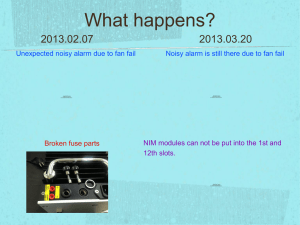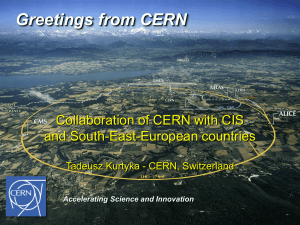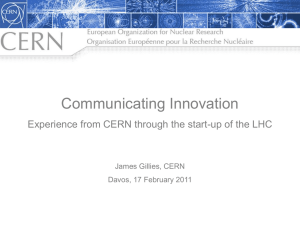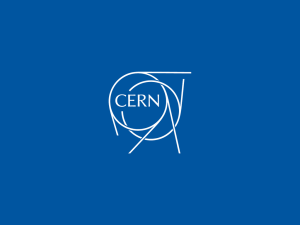Switzerland and CERN: a History of Fifty years
advertisement
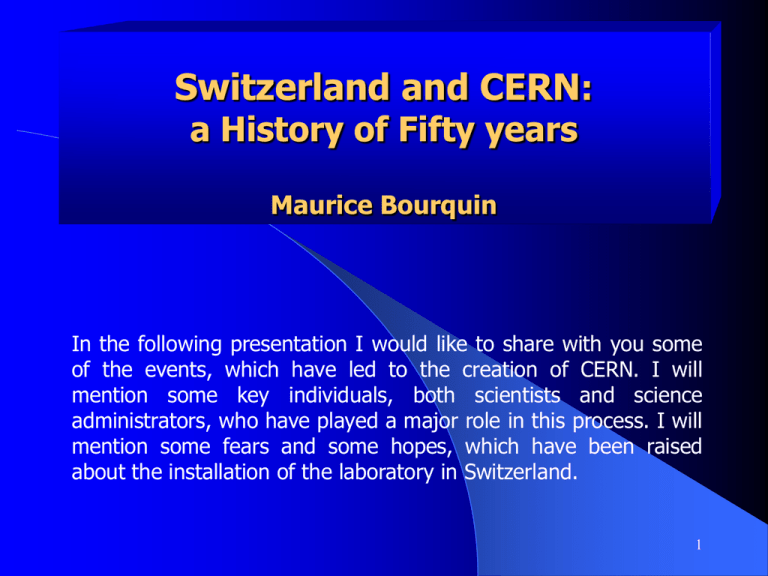
Switzerland and CERN: a History of Fifty years Maurice Bourquin In the following presentation I would like to share with you some of the events, which have led to the creation of CERN. I will mention some key individuals, both scientists and science administrators, who have played a major role in this process. I will mention some fears and some hopes, which have been raised about the installation of the laboratory in Switzerland. 1 The creation of a new organism, whether an individual or an institution, follows a series of phases: The initial idea, the conception, the birth, and the development. I will try to identify these phases in the case of CERN 2 The initial idea is rather difficult to pinpoint precisely. One generally mentions the European Conference on Culture organized in December 1949 in Lausanne, where Denis de Rougemont, the famous Swiss writer, was very active. After meeting with Albert Einstein in March 1947 in Princeton, Denis de Rougemont was convinced that one should link the ideas of European union and of mastering nuclear energy: ‘deux choses à ce moment-là aussi frappantes par leur nouveauté que par leur mutuelle utilité.’ 3 Raoul Dautry (who then was working with Joliot-Curie at the Commissariat français à l’énergie atomique) has been quoted during the Lausanne Conference saying: que les états européens unissent leurs efforts! Il est temps de réaliser une institution européenne dans le domaine de l’énergétique. Je veux dire pour être plus précis dans celui de l’infiniment grand, source de l’énergie cosmique, et dans celui de l’infiniment petit, source de l’énergie atomique’. He was thus proposing the creation of an atomic physics and astrophysics laboratory. Dautry also read a message from Louis de Broglie, the creator of wave mechanics, in favor of European cooperation in scientific matters. 4 These ideas of international scientific collaboration, still on a very general level, had been discussed since 1946 during various meetings among physicists, especially nuclear physicists as E. Amaldi, I. Rabi, L. Kowarski, and P. Auger. I can imagine they were certainly aware of the discussions on Science being held in parallel in the USA, discussions which led to what has been called ‘the post-war roots of the U.S. Science System.’ In 1945, a professor named Bush, Vannevar Bush, President’s Roosevelt top science advisor, published The Endless Frontier. I cannot resist quoting two short extracts, as they correspond to considerations debated even today in Europe and in Switzerland. I expect that our secretary of state, Charles Kleiber, is also supporting them. 5 Vannevar Bush, The Endless Frontier: “We can no longer count on ravaged Europe as a source of fundamental knowledge. In the past we have devoted much of our best efforts to the application of such knowledge, which has been discovered abroad. In the future we must pay increased attention to discovering this knowledge for ourselves particularly since the scientific applications of the future will be more than ever dependent upon such basic knowledge.“ “The most important ways in which the Government can promote industrial research are to increase the flow of new scientific knowledge through support of basic research, and to aid in the development of scientific talent.“ 6 These ideas led to the development of the US national funding agencies such as the National Science Foundation and started a process of co-evolution of funding processes and research intensive university capability, so that US basic research (and the knowledge transfer from it) is now largely conducted in its universities, and strategic and applied research by government and industry. However, no matter how useful these discussions were on a possible European laboratory for physics and astrophysics, concrete actions needed an official framework to reach the public authorities and have them engage in such an enterprise. The occasion was given by the intervention of the Centre Européen de la Culture headed by Denis de Rougemont. The CEC, from 1950 on, was entrusted in the discussion on the choice of the domain to be developed and on how to recruit volunteers to carry the action. 7 The profile of CERN was taking shape: its program, the construction of a 10 GeV accelerator, located in Europe. On the Swiss side one should recognize the efforts of two individuals, which played the role of ‘scientific statesmen’, P. Scherrer and P. Preiswerk. It was decided that UNESCO would call on government representatives to study with them financing the plan and establishing international conventions. The role of UNESCO was, in short, to carry the project discussed in Lausanne (1949), in a further meeting in Geneva (CEC, 1950), and in many other places, to the level of intergovernmental negotiations. Thus, Switzerland played an important role in the idea of CERN and UNESCO became its godmother. 8 The conception In December 1951 and February 1952, two sessions of a conference sponsored by UNESCO were held in Paris and Geneva, the result of which was the creation of a Council of European representatives for studying plans for an international laboratory and the organization of other forms of cooperation in nuclear research. The Conseiller d’Etat from Geneva Albert Picot and the physicist from ETHZ Paul Scherrer, the two delegates from the Swiss Confederation, already indicated at this moment that Switzerland could be designated as seat of the laboratory. 9 10 In January 1952, the Tribune de Genève had presented the arguments in favor of Geneva: important scientific heritage, available electric power, highly specialized manpower, small country, neutrality ensuring that the research would be used exclusively for peaceful purposes. 11 On October 4 of the same year 1952, the Council, meeting in Amsterdam, chose Geneva among 4 candidate cities According to A. Picot, the technical offers (quality of ground, availability of water and electricity) were the same for all four 12 (Arnhem, Geneva, Copenhagen, Paris). Geneva was chosen because of ‘de l’intérêt qu’elle avait manifesté pour la physique en construisant dès 1944 un très vaste Institut de cette science’ Indeed, four days later, took place the official inauguration of the new building of the Physics Institute of the University of Geneva. 13 Furthermore, Geneva was described as a pleasant place to live, with numerous educational resources for the children of scientists and the advantage of already having many foreign communities. Clearly the weight of the various political alliances between the large European nations in this post-war period in Europe also played a significant role. The choice of a Swiss site would remove all doubts about the intention of the organization to pursue only scientific work. However, within Geneva itself, there was no such consensus: Part of the population, following the arguments of the communist party, expressed various dangers, which the installation of the laboratory would present (dangerous fumes, risk of bombardment in the event of a new war, threat to the Swiss neutrality). 14 When in December 1952, Albert Picot presents the project to the parliament of Geneva, the left-wing rejects it vehemently, claiming ‘l’inféodation du futur organisme puissances du Pacte Atlantique’. scientifique aux It is in vain that the representative of the Conseil d’Etat explains that, on the contrary : ‘c’est pour se libérer de l’influence de l’Amérique que les savants d’Europe ont décidé de mettre leurs efforts en commun’. 15 The communist party gathers enough signatures to present a popular initiative forbidding the installation of any international institution conducting atomic or nuclear research in Geneva. 16 Surprisingly, to me at least, this initiative was supported by personalities such as William Rappard, who was against a movement of European concentration. I recall that Professor Rappard was, until 1955, director of the now notorious Graduate Institute of International Studies in Geneva and representative of Switzerland in many diplomatic missions. He was also opposed to the establishment of the European Coal and Steel Community and to the Council of Europe. 17 Before the date set for the popular vote (on June 28 and 29, 1953), a very hard campaign took place in Geneva, where scientists went into the street. Fortunately for CERN and Switzerland the initiative was repelled. 18 And two days later, on July 1st 1953, the Swiss delegation to a session of CERN Council in Paris was able to sign the Convention for the establishment of CERN. It still had to be ratified by the 12 countries signing 19 Let me quote from a 1954 conference of Albert Picot, a jurist, where he acknowledges the human aspects revealed by atomic energy. a) Les dangers évidents de cette physique révélés à Hiroshima, à Nagasaki et à Bikini ; b) Les perspectives économiques magnifiques de la découverte de nouvelles sources d’énergie pour remplacer le charbon, le pétrole et l’électricité; c) Les problèmes passionnants posés à l’esprit humain par l’évolution de la science depuis 60 ans (Roentgen 1895). We should acknowledge his vision and work toward a Switzerland of the future, betting on progress of the human mind and in the evolution of society, rather than being too nostalgic about a past society or lost privileges. 20 Even before the Convention was ratified and before CERN was officially born, a small staff of physicists and engineers operated in semi-independent subgroups spread in several countries. In October 1953, it was possible for the whole Proton Synchrotron Project group (Hine, Adams, Citron, Schnell, etc) to move to Geneva in the Institute of Physics. Laboratories and shop facilities were made available and furnished offices were placed at their disposal. 21 22 23 At the end of the same month an international conference was organized at the Institute. It was entitled: ‘the Theory and Design of an Alternating-Gradient Proton Synchrotron’. The Project Group explained that the previous year the goal was to design a machine similar to the one at Brookhaven in the USA, but with a somewhat larger energy of 10 GeV. However, as a team of American scientists had just introduced them to a revolutionary concept, the alternating-gradient principle, their working program had changed drastically. They now envisaged a 30 GeV machine, having a smaller aperture and smaller magnets, but keeping the same budget. This certainly required boldness and courage, but was a very good decision. This machine was built and is still in operation today. 24 Birth of CERN The year 1954 witnessed the birth of CERN, whose 50th anniversary we are celebrating this year. On May 17, the construction of the buildings started on the Meyrin site. By September 29, the CERN Convention had been ratified by nine states, including Switzerland. By early 1957, when staff and labs moved to Meyrin, good progress had been made on designing the PS. With one incident perhaps, in February 1956, when the ‘rade de Genève’, froze up – the last time this occurred during the 20th century – and so did the heating pipes in the temporary barracks that had been erected next to the Institute to house additional collaborators. 25 26 Development of CERN Since this period, Switzerland has not been sorry for its decision to offer a safe haven for CERN and CERN has followed a harmonious course. We can ask, fifty years later, what links have been woven between the Organization and Switzerland, and also what happened to the hopes and fears that had been put forward by the partisans and the opponents to the installation of the laboratory in the canton of Geneva. On the links firsts. It is clear that since the ratification of the Convention in 1954, the good relations between CERN and Switzerland have been strong and numerous. 27 Many experimental and theoretical physics groups from Swiss universities and ETH have participated to scientific projects at CERN. This has naturally enhanced the quality of education of many research students. Swiss scientists have contributed to the publication of hundreds of scientific and technical papers in international journals. CERN has greatly contributed to inverse the flux of Swiss scientists toward the USA (my case for example!). The setting up of high performance computer networks in Switzerland would not have been realized so early without the close collaboration with CERN. The proximity of CERN has been of great benefit to the private sector. There has been years, when the industrial return to Switzerland amounted to nine times its financial contribution! Not to mention the transfer of knowledge developed at CERN to many Swiss firms. 28 Switzerland and the canton of Geneva, on their side, have strongly supported the activities of CERN. For example, there has been a continuous presence to the Council of the Organization of high level government representatives ( the conseillers d’états from Geneva A. Picot, A. de Senarclens, A. Chavanne, J. Vernet et Ph. Joye and presently our Secretary of state Charles Kleiber). Special financial contributions have been granted to new projects, recently to the colliders LEP and LHC, as well as to the neutrino beam directed to the Gran Sasso laboratory. The SNF should also be commended for its continuous support to many projects at CERN, although I share now with many colleagues their worries about the present lower level of investment of the SNF in this field. 29 Mais les relations du CERN avec sa région ne se limitent pas à la Suisse, elles englobent également la France voisine, surtout depuis que le CERN s’est étendu en 1965 au territoire du pays de Gex voisin pour permettre la construction des ISR, puis du SPS. Cette dualité territoriale est d’ailleurs unique au monde et le CERN fait office de précurseur en matière juridique et commerciale. 30 L’impact du CERN sur la région avoisinante franco-suisse a de multiples facettes. C’est un facteur de la dynamique économique par la masse salariale et les commandes importantes qui y sont passées chaque année, et aussi par le terrain d’expérimentation privilégié qu’il offre pour certains groupes industriels installés dans la région. C’est un facteur de développement social par le capital humain qu’il met à disposition de nombreux organismes locaux de formation professionnelle, universitaire et grand public. Et aussi par l’implantation d’une population importante et de haut niveau d’éducation. Le caractère fondamental et non secret de la recherche contribue à créer un climat particulièrement propice aux échanges. On the hopes and fears now. The threats invoked by the opponents to CERN have not materialized. Obviously CERN does not deal with nuclear power and does not have to worry about the issues of nuclear safety. Nevertheless thanks to the rigorous measures taken at CERN, the impact of the CERN installations on environment has remained small. There has been no pollution or radiological event dangerous to the population. 31 Rather than threatening the neutrality of Switzerland, CERN has contributed to develop ‘l’Esprit de Genève’, in the scientific domain as well. Thanks to the international status granted by the host countries, there is no restriction of access to CERN. This is an enormous advantage in the development of science. We recognize this fact very acutely these days, when at present so many scientists are not obtaining visas to participate in scientific projects and meetings in the USA. In spite of the difficulties to maintain scientific collaborations with countries in political confrontations with each other, CERN was during the cold war one of the rare meeting points between East and West. More recently, new collaboration agreements have been signed with, for example, India and Pakistan. CERN remains, as in the process of its creation, an international organization capable of diminishing through scientific collaboration the gap between world powers. 32 Since half a century, CERN users have come from more and more different parts of the world 33 Swiss scientists have had the great opportunity to collaborate with them, while essentially staying at home! They have used a succession of accelerators and colliders at CERN of higher and higher energies. In the beginning, in the 50’s, the goal was mainly to understand the intimate structure of the nuclei of the atoms and the forces that keep them from falling apart, which is studying nuclear physics. But machine after machine, the collision energy between accelerated particles has increased, recreating, during very short times and in a very confined space, the conditions of temperature and pressure that existed a fraction of a second after the big-bang, the event, which saw the birth of the Universe. Thus the physicists have also undertaken to study the history of the Cosmos. 34 The last ten years or so, we are observing the birth of a new branch of science, a symbiosis between particle physics, astrophysics and cosmology. Using the technology of particle detectors developed for accelerator experiments at CERN and elsewhere, physicists are preparing to detect particles accelerated by cosmic phenomena, a complementary search for anti-matter, dark matter and high energy astrophysics objects. CERN is providing the home base for such exciting projects as the Pierre Auger Laboratory in Argentina or the Alpha Magnetic Spectrometer on the ISS. 35 Ladies and Gentlemen, in the late 1940’s high energy physics had not yet emerged as a field distinct from nuclear research linked to immediate industrial or defense applications. Please notice the wisdom of the CERN forefathers, who defined its mission in the 50-year old CERN Convention, still in effect today, that The Organization shall ‘confine its activities … for research on high-energy particles, including work in the field of cosmic rays’. In the beginning of the 21st century, when our knowledge of our Universe is still very limited, these domains of research have still the greatest potential for our cultural development in Switzerland, in Europe and in the world. 36

